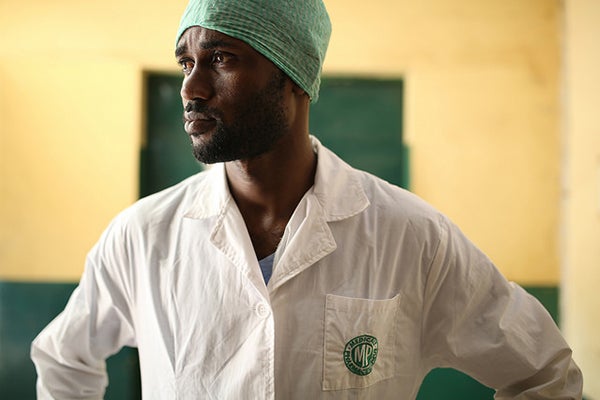This blog first appeared on Devex.com and is being reproduced here with their permission.
Little more than a year after the Ebola crisis in West Africa tragically highlighted the inadequacy of pandemic preparedness and response, the current Zika outbreak in the Americas has brought the issue back to the top of the global health agenda.
It is early days and there is much we still do not know about Zika, including whether there is a causal link between the virus and the observed increase in microcephaly and Guillain-Barre syndrome in some countries in Latin America. But one thing that both Ebola and now Zika have made clear is that the world has to get serious about pandemic preparedness and response.
Pandemics as an economic threat

Center in Conakry, Guinea on March 16, 2015.
Photo © Dominic Chavez/World Bank
The costs of inaction are immense. Pandemics pose a serious threat not only to global health security, but also to economic security and to our ability to end extreme poverty and achieve the Sustainable Development Goals. Ebola wiped out many of the recent development gains in Guinea, Liberia and Sierra Leone, which were among the fastest growing economies in the world prior to the crisis.
In April 2015, the World Bank Group estimated losses on the gross domestic product for the three countries last year rose to $2.2 billion. And even though the Ebola epidemic has been stopped in its tracks, the countries are still reeling from the impact. While our initial economic impact estimate for Zika is more moderate for Latin America and the Caribbean, there is still significant uncertainty about how this crisis will play out over the near future.
That’s why in the past decade we at the WBG have stepped up our focus on the threat of global pandemics.
In 2006, we set up a global program on avian influenza, which provided low- and middle-income countries with access to financing to address the threat. Between 2014 and 2015, we committed $1.6 billion to help Guinea, Liberia and Sierra Leone to help end the Ebola epidemic and invest in recovery, including strengthening their health systems and improving outbreak preparedness. And we recently made financial support available to countries in Latin America and the Caribbean to mount a robust response to the Zika virus.
Investing in pandemic preparedness
However, the world’s total investments in pandemic preparedness and response still remain woefully insufficient. Pandemics usually attract attention when they are at their height. But once the worst is over they disappear from the headlines, the sense of urgency disappears both at the global and country government level until the next time, and we start all over again.
The good news is that the lessons of Ebola seem to finally be translating into longer-term solutions. Over the past year, four different global expert groups have analyzed the fault lines of the response, and have made a number of recommendations about how the world should face pandemic threats. Initial indications show an earlier and more nimble response to Zika in recent weeks, both globally as well as on the part of governments in the affected region. Yet Zika continues to spread and place millions of people, particularly pregnant women, at risk.
Our contribution to improving pandemic risk management is in the area of financing. Investing in preparedness, including by building resilient health systems, is the bedrock for managing pandemic risk, and investments must be multifaceted, including but going well beyond the health sector. And though aid is usually directed at individual countries, infectious disease threats do not stop at national borders. Regional and global investments are also critical and can be cost-effective.
For example, essential disease surveillance and diagnostic capabilities in many developing countries are often not up to the task of rapidly testing large numbers of people, leading to a deadly lag in response times. The East Africa Public Health Laboratory Networking Project, which we support, has brought together five countries with the aim of establishing high quality, accessible public health laboratories for disease surveillance.
Similarly, the West Africa Regional Disease Surveillance Capacity Strengthening Project, which will be launched later this year, will work with 15 ECOWAS countries to build Integrated Disease Surveillance and Response action plans that draw on regional centers of excellence. And the Global Financing Facility for Every Woman Every Child, which we partnered with Canada, Norway, the United States, Japan, the Bill & Melinda Gates Foundation, the United Nations and many others to design, will scale up investments in core public health capacities such as training community health workers in Liberia.
Ensuring swift pandemic response
However, even strong health systems could be overwhelmed by a large-scale disease outbreak, and so investing in pandemic response is equally essential. Together with the World Health Organization and many other partners, and with the support of the Group of Seven, we are developing a new Pandemic Emergency Financing Facility.
The PEF will be a quick-disbursing financing mechanism that will be able to provide a surge of funds aimed at effective response. It is an innovative financing model, using a combination of public and private funds, to cover low-frequency, high-severity outbreaks. It will be an insurance-based mechanism, with clear activation criteria based on publicly available data. Once activated, money from the PEF can flow to both countries and accredited international responders, including United Nations agencies, nongovernmental organizations and multilateral development banks.
The PEF aims to fill a gap in the current pandemic response financing architecture, which is too dependent on “pass the hat,” donor-by-donor financing that varies in scale and often comes in too late for a fast-moving, deadly outbreak. In so doing it will help save lives and money, speed up response times, and bring more predictability, discipline, and rigor to country and global pandemic response.
Last week, I participated in the meeting of the Global Health Security Initiative, an international partnership to strengthen health system preparedness and pandemic response. It’s heartening to see the strong and growing commitment to this agenda from so many countries. And for the second year in a row, global health security is a main topic for G-7 leaders, who will next meet in late May at the Isay-Shima summit in Japan. Our hope is that these combined efforts will result in a systemic change in how the world addresses future pandemic threats — which, in turn, is an essential step on the road to achieving the larger global goals of universal health coverage and ending poverty.


Join the Conversation